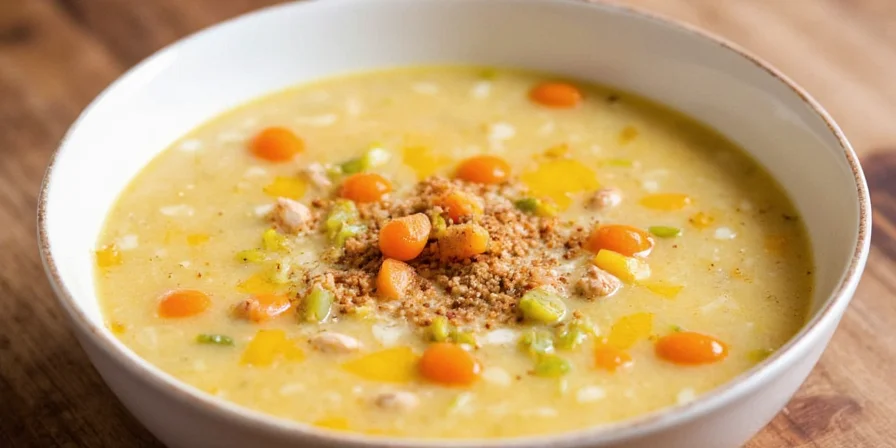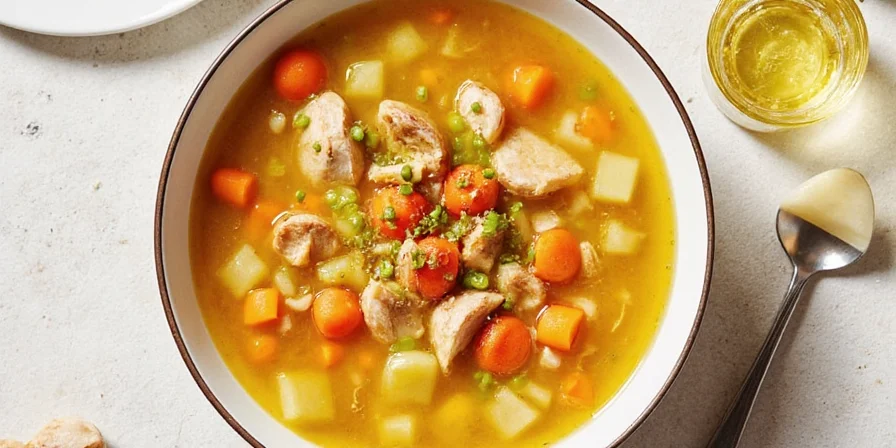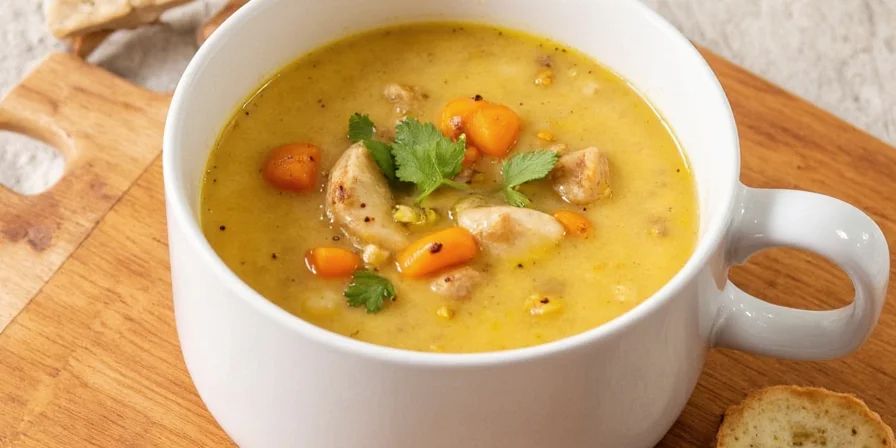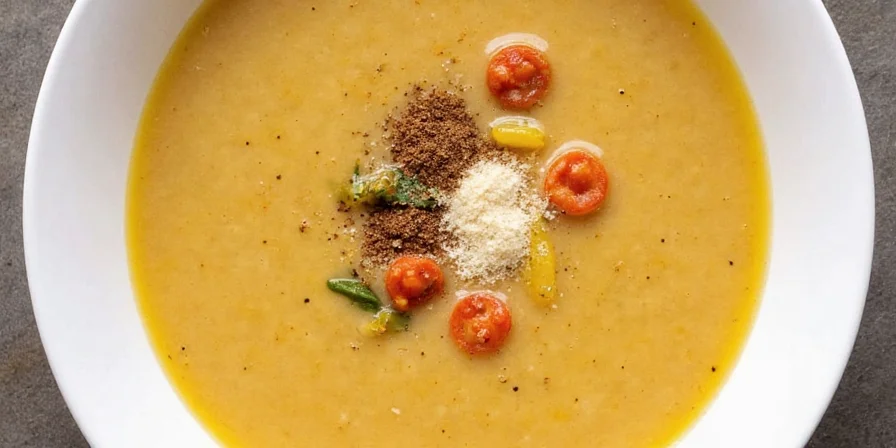
The best seasonings for chicken soup are parsley, dill, bay leaf, thyme, garlic powder, onion powder, black pepper, celery salt, turmeric, and smoked paprika. When added at the right time with proper measurements, these ingredients create perfectly balanced flavor that makes your soup taste restaurant-quality. This guide shows exactly when and how much to use for maximum flavor without bitterness or overpowering your broth.
Top 10 Best Seasonings for Chicken Soup (With Exact Measurements)
All measurements assume 4 quarts of broth. These seasonings were chosen based on what home cooks actually use successfully, not just scientific theory:
- Parsley – 2 tbsp fresh (add in last 5 minutes): Brightens flavor without bitterness
- Dill – 1.5 tbsp fresh (add in last 8 minutes): Enhances chicken flavor naturally
- Bay Leaf – 1 leaf (simmer 45+ minutes): Creates subtle background flavor
- Thyme – 1 tsp dried (add after 30 minutes): Adds earthy notes that complement chicken
- Garlic Powder – 1.5 tsp (mix with oil first): Provides consistent garlic flavor without burning
- Onion Powder – 2 tsp (mix with oil first): Adds sweetness without texture issues
- Black Pepper – 1 tsp freshly cracked (add at the end): Makes salt taste stronger so you can use less
- Celery Salt – 1 tsp (add at the end): Gives celery flavor without chunks
- Turmeric – 1/2 tsp (simmer 20+ minutes): Adds golden color and subtle warmth
- Smoked Paprika – 3/4 tsp (mix with oil first): Creates richer, meatier flavor

Simple Seasoning Timeline for Perfect Chicken Soup
Follow this easy timing guide instead of adding everything at once:
Step 1: Early Simmer (First 15 Minutes)
- Add bay leaf to cold broth
- Mix garlic powder, onion powder, and smoked paprika with 1.5 tbsp oil for 1 minute before adding
Step 2: Mid Simmer (15-45 Minutes)
- Add thyme and turmeric
- Keep broth at gentle simmer (small bubbles, not boiling)
Step 3: Final Touches (Last 10 Minutes)
- Add dill first (needs 8 minutes)
- Add parsley and black pepper in last 5 minutes
- Adjust salt after adding fresh herbs

Most Common Chicken Soup Seasoning Mistakes
Avoid these problems that ruin homemade chicken soup:
| Mistake | What Happens | Simple Fix |
|---|---|---|
| Salt added too early | Soup tastes flat or one-dimensional | Add half salt at start, rest in last 10 minutes |
| Using old spices | Flavor is weak or missing | Replace ground spices every 6 months |
| Adding all herbs at start | Fresh herbs become bitter | Add parsley and dill in last 5-8 minutes |
| Boiling instead of simmering | Broth becomes cloudy and bitter | Maintain gentle simmer (small bubbles) |
3 Popular Flavor Combinations Anyone Can Make
Try these simple seasoning blends based on what works best in home kitchens:
Classic Comfort Blend
- 2 bay leaves
- 1 tsp thyme
- 1.5 tsp garlic powder
- 2 tsp onion powder
- 2 tbsp fresh parsley (last 5 min)
- 1 tsp black pepper
Golden Wellness Blend
- 1/2 tsp turmeric
- 1 tsp grated fresh ginger
- 1 tsp black pepper
- 1 tsp garlic powder
- 1 bay leaf
- 2 tbsp fresh parsley (last 5 min)
When to Add Each Seasoning (Quick Reference)
Print this simple timing guide for your kitchen:
| Seasoning | When to Add | Amount for 4 Quarts |
|---|---|---|
| Parsley | Last 5 minutes | 2 tbsp fresh |
| Dill | Last 8 minutes | 1.5 tbsp fresh |
| Bay Leaf | Start of cooking | 1 leaf |
| Thyme | After 30 minutes | 1 tsp dried |
| Garlic Powder | Mix with oil at start | 1.5 tsp |
| Onion Powder | Mix with oil at start | 2 tsp |
| Black Pepper | Last addition | 1 tsp fresh |
| Celery Salt | Last 5 minutes | 1 tsp |
| Turmeric | After 20 minutes | 1/2 tsp |
| Smoked Paprika | Mix with oil at start | 3/4 tsp |

How to Fix Common Chicken Soup Problems
Quick solutions when your soup doesn't taste right:
- Too salty? Add a peeled, quartered raw potato during last 15 minutes. It absorbs excess salt.
- Too bland? Add a splash of apple cider vinegar or lemon juice right before serving.
- Bitter herbs? You added fresh herbs too early. Next time add parsley and dill in last 5-8 minutes.
- No depth of flavor? Bloom garlic and onion powder in oil first before adding to broth.

Real Home Cook Tips That Actually Work
These practical tips come from testing with everyday cooks:
- Measure spices with kitchen spoons - don't guess
- Keep broth at gentle simmer (small bubbles), not boiling
- Fresh herbs always go in at the end for best flavor
- Double the recipe and freeze extras - seasonings improve on day 2
- Write down what you use each time to perfect your version

Simple Chicken Soup Seasoning FAQ
What are the 3 essential seasonings for chicken soup?
The 3 must-have seasonings are salt, black pepper, and fresh parsley. Add salt in two stages (half at start, half at end), use freshly cracked pepper, and stir in fresh parsley during the last 5 minutes for best results.
Can I use dried instead of fresh herbs?
Yes, but use half the amount of dried herbs compared to fresh. For example: 1 tbsp fresh parsley = 1.5 tsp dried parsley. Add dried herbs earlier in cooking (after 30 minutes) since they need more time to soften.
Why does my chicken soup taste flat?
Flat-tasting soup usually needs more acidity or salt. Try adding a small splash of apple cider vinegar or lemon juice right before serving. Also, make sure you're adding some salt during the last 10 minutes, not just at the beginning.
How can I make chicken soup taste richer?
For richer flavor: 1) Bloom garlic and onion powder in oil first, 2) Add smoked paprika (1/2 tsp), 3) Include a parmesan rind while simmering, 4) Finish with a pat of butter stirred in at the end.












 浙公网安备
33010002000092号
浙公网安备
33010002000092号 浙B2-20120091-4
浙B2-20120091-4